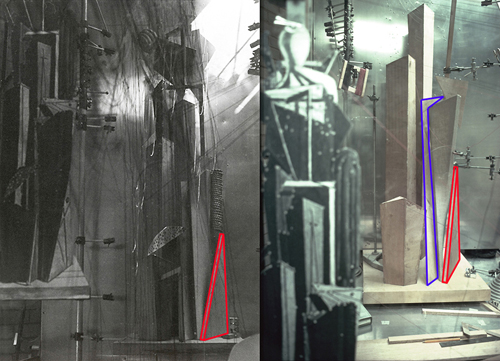At this point, somewhat tedious but necessary technical references are required. It seems that no modern mystery is complete without them. The constructions on the left and right of centre in La macchina metafisica 3-Projections, represent the first two attempts at projecting the Metaphysician from a pictorial image into a 3-dimensional object. The large setsquare on the base of the figure was used as the datum, the point of referral between the painted image and its 3-dimensional counterpart. Since there are only two setsquares in common usage (45°/90° and the 60°/30°) two versions were projected (fig.1). In these projections the various shapes were arrived at via an architectonic process that started with the datum setsquare, followed by the ground plan on the base, and then the rest of the shapes were constructed in a vertical point-to-point sequence.
During the projecting and constructing stages in versions one and two, in which I tried to be as objective as possible, the anomalies inherent in the painting became increasingly apparent. Not only was the painting as a whole dislocated due to its several uncoordinated light sources and vanishing points, but several of the Grand Metaphysician’s components appeared ambiguously distorted. More obvious examples are the stretched canvas-like shape on the base of the assemblage, which appears simultaneously to recede and advance as if twisted through 90° (fig.2), and the technical drawing-like shape situated next to it, which also appears ambiguously twisted (fig.1 outlined in blue). This type of formal slippage features in many of De Chirico’s paintings and invariably occurs within rigorously controlled compositional frameworks that suggest a world that is simultaneously static whilst also in perpetual flux. Hence, during the making of the second projection it became increasingly apparent that reconstructing the Grand Metaphysician in the form of a statue-like assemblage did not reflect its inherent fluxing characteristics. As a result of this observation a third version came into being, which simultaneously appeared to expand and contract. Unlike the first two projections it made no attempt to control the image of the Metaphysician as a statue-like vertical assemblage. In contrast, it created a visual metaphor predicated upon the concept of metastasis in order to exemplify its fluxing characteristics. Metastasis is used throughout to indicate an object that is static whilst also resonating in a state of flux - i.e. dissolution and becoming.
In the third projection multiple versions of what appear to be singular shapes in the painting are used to denote the concept of ‘beyond movement’ or metastasis, as exemplified by the pivotal point between centripetal and centrifugal forces. As one walks around the projection one becomes aware of the ambiguous centripetal - centrifugal relationship that is inherent in the projection and its relationship to its mode of projection. When moving towards the eye-piece (the point of projection) the multiple components realign into the recognisable form of the Grand Metaphysician, as seen in the painting. Conversely, if one continues to walk around the projection the image dissolves into its fluxing components. The psychological uncertainty created by this shift in the assemblage’s centrifugal and centripetal alignment, ultimately creates a sense of metastasis. It is the uncertainty of an object perpetually alternating between a state of becoming and dissolution – the Apollonian-Dionysian state.
 1
1 2
2